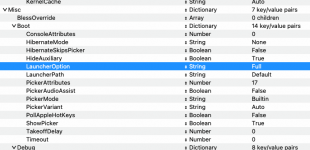I think the issue might be that I created my Installation USB on Windows using Rufus and that it doesn't create the EFI/GUID Partition Table on the USB drive. So, I did copy over the EFI folder from the USB it's not the hidden one (because there isn't one).
That being said, I can boot into Ventura (via USB) and am trying to recreate the USB drive using the MacOS instructions so I can get the hidden EFI folder. However, my Ventura install keeps rebooting after about 10-15 minutes (not enough time to download the installer).
Here is the latest kernel panic:
panic(cpu 0 caller 0xffffff8012d485f3): Kernel trap at 0xffffff801313ce34, type 14=page fault, registers:
CR0: 0x000000008001003b, CR2: 0x0000040000000010, CR3: 0x0000000021288000, CR4: 0x00000000003406e0
RAX: 0x0000000000000000, RBX: 0x0000040000000000, RCX: 0x0000000000000002, RDX: 0x0000000000000188
RSP: 0xffffffaccbdfbdb0, RBP: 0xffffffaccbdfbdb0, RSI: 0x0000040000000000, RDI: 0x0000040000000000
R8: 0x0000000000000004, R9: 0x0000000000000000, R10: 0x00000000000000ff, R11: 0x00000000000007fc
R12: 0x0000000000000001, R13: 0xffffffffc059c600, R14: 0xffffffffc059c600, R15: 0xffffff9028a0f500
RFL: 0x0000000000010206, RIP: 0xffffff801313ce34, CS: 0x0000000000000008, SS: 0x0000000000000010
Fault CR2: 0x0000040000000010, Error code: 0x0000000000000000, Fault CPU: 0x0, PL: 0, VF: 1
Panicked task 0xffffff99c0df5208: 220 threads: pid 0: kernel_task
Backtrace (CPU 0), panicked thread: 0xffffff94f4f3e598, Frame : Return Address
0xffffffaccbdfb790 : 0xffffff8012beb38d
0xffffffaccbdfb7e0 : 0xffffff8012d58ed6
0xffffffaccbdfb820 : 0xffffff8012d48120
0xffffffaccbdfb870 : 0xffffff8012b85951
0xffffffaccbdfb890 : 0xffffff8012beb66d
0xffffffaccbdfb980 : 0xffffff8012bead19
0xffffffaccbdfb9e0 : 0xffffff80133e072b
0xffffffaccbdfbad0 : 0xffffff8012d485f3
0xffffffaccbdfbc50 : 0xffffff8012d482e2
0xffffffaccbdfbca0 : 0xffffff8012b85951
0xffffffaccbdfbcc0 : 0xffffff801313ce34
0xffffffaccbdfbdb0 : 0xffffff8014af204a
0xffffffaccbdfbe10 : 0xffffff8014c8efb9
0xffffffaccbdfbe80 : 0xffffff8014a331e3
0xffffffaccbdfbed0 : 0xffffff80133144b4
0xffffffaccbdfbf20 : 0xffffff8013312dae
0xffffffaccbdfbf60 : 0xffffff80133123e7
0xffffffaccbdfbfa0 : 0xffffff8012b8519e
Kernel Extensions in backtrace:
com.apple.driver.AirPort.BrcmNIC(1400.1.1)[168E8B42-4E91-366A-AD27-78AF8BE04325]@0xffffff80149fa000->0xffffff8014f53fff
dependency: com.apple.driver.corecapture(1.0.4)[1EFC00FC-8337-39AF-B061-EDA1CB53C6E7]@0xffffff8015e4a000->0xffffff8015e6cfff
dependency: com.apple.driver.mDNSOffloadUserClient(1.0.1b8)[C3FDAE90-94DE-3A8C-97AF-DA3D79487FC3]@0xffffff8015652000->0xffffff8015656fff
dependency: com.apple.iokit.IO80211FamilyLegacy(1200.12.2b1)[8CB6AB86-0DC8-324C-A9F7-B46C452522DD]@0xffffff8014898000->0xffffff80149defff
dependency: com.apple.iokit.IONetworkingFamily(3.4)[ACD4449A-4F90-31DB-82AD-2F2B83D8F6E3]@0xffffff80153f8000->0xffffff801540efff
dependency: com.apple.iokit.IOPCIFamily(2.9)[802B9CA4-B851-396E-8DA4-B30E751EC48F]@0xffffff8015659000->0xffffff8015688fff
dependency: com.apple.iokit.IOSkywalkFamily(1.0)[337AFA35-6288-3EA9-BC6E-AA8E075EECF6]@0xffffff8015742000->0xffffff801576ffff
Process name corresponding to current thread (0xffffff94f4f3e598): kernel_task
Boot args: alcid=1 agdpmod=pikera
Mac OS version:
22D68
Kernel version:
Darwin Kernel Version 22.3.0: Mon Jan 30 20:42:11 PST 2023; root:xnu-8792.81.3~2/RELEASE_X86_64
Kernel UUID: 10E5D254-4A37-3A2A-B560-E6956A093ADE
roots installed: 0
KernelCache slide: 0x0000000012800000
KernelCache base: 0xffffff8012a00000
Kernel slide: 0x00000000128dc000
Kernel text base: 0xffffff8012adc000
__HIB text base: 0xffffff8012900000
System model name: MacPro7,1 (Mac-27AD2F918AE68F61)
System shutdown begun: NO
Panic diags file available: YES (0x0)
Hibernation exit count: 0
System uptime in nanoseconds: 392796288100
Last Sleep: absolute base_tsc base_nano
Uptime : 0x0000005b747bb716
Sleep : 0x0000000000000000 0x0000000000000000 0x0000000000000000
Wake : 0x0000000000000000 0x000000191a8aeaf0 0x0000000000000000
Compressor Info: 0% of compressed pages limit (OK) and 0% of segments limit (OK) with 0 swapfiles and OK swap space
Zone info:
Zone map: 0xffffff84f2a4d000 - 0xffffffa4f2a4d000
. PGZ : 0xffffff84f2a4d000 - 0xffffff84f6a4e000
. VM : 0xffffff84f6a4e000 - 0xffffff89c2d81000
. RO : 0xffffff89c2d81000 - 0xffffff8b5c3e7000
. GEN0 : 0xffffff8b5c3e7000 - 0xffffff902871a000
. GEN1 : 0xffffff902871a000 - 0xffffff94f4a4d000
. GEN2 : 0xffffff94f4a4d000 - 0xffffff99c0d80000
. GEN3 : 0xffffff99c0d80000 - 0xffffff9e8d0b3000
. DATA : 0xffffff9e8d0b3000 - 0xffffffa4f2a4d000
Metadata: 0xffffff803fdb7000 - 0xffffff805fdb7000
Bitmaps : 0xffffff805fdb7000 - 0xffffff806bdb7000
